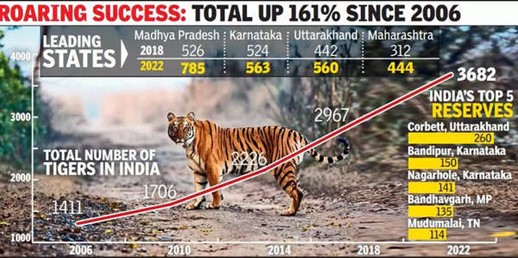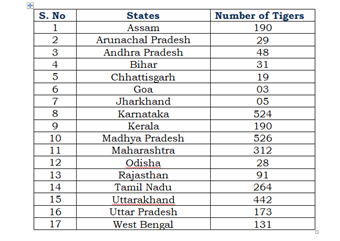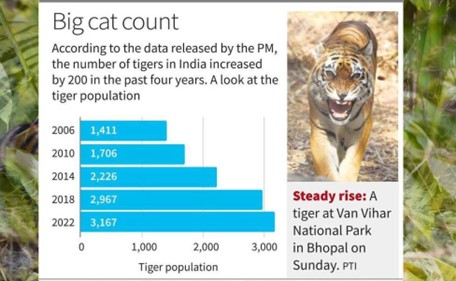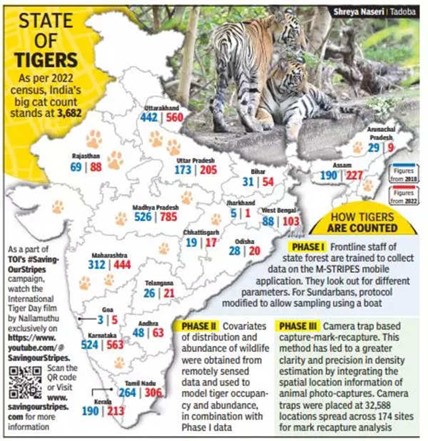PREVIOUS
Tiger population 2023 in India – Part I
August 16 , 2023
618 days
55048
0
(இதன் தமிழ் வடிவத்திற்கு இங்கே கொடுக்கவும்)
Tiger population 2023 in India

- There are 3682 tigers are now in India.
- Up from 2967 in 2018 a rise of almost 24% in four years.
- The numbers are also up from the 3167 tigers announced by PM Narendra Modi in Mysuru on April 9 at a programme to commemorate 50 years of project.
- The tiger population estimate report is usually published after a gap of four years in the country.
- It will be taken by the NTCA and Wildlife Institute of India with support from respective state forest departments.
- Wildlife Institute of India director VK Tiwari said 3,167 is the minimum count as per photographs of tigers while the average is 3,682.
- There are a maximum of 3925 tigers in the country.
- It is the population estimate arrived at by them after extrapolation of all data.
- It is including pictures, pug marks and other sign indicators like scat.
- According to the latest census, the total number of tigers in India has seen a remarkable increase of 200.
- It is surging from 2,967 to 3,167 over the last four years.

- Tiger’s conservation effort was applauded across the world.
- The revised figures follow detailed analyses of census of data collected during the fifth cycle of estimation conducted in 2022.
- This commendable feat highlights the unwavering commitment to wildlife conservation in India.
- It signifies the collective efforts of the government, conservationists and local communities.
- A significant achievement as India now has 75% of the world’s tiger population.
- Their numbers are growing at a pace of 6% annually.
- This is a significant improvement from 1973 which has revealed the following.
- Tigers in India were quickly becoming extinct due to habitat loss, hunting, poaching, and killings by locals.
- The Government of India started Project Tiger to address this issue.
- It is resulting in 53 tiger reserves in India, up from nine when the project began.
- Tiger numbers are almost doubled from 2006 to 2018, reaching 2,967, and are now above 3,000.
- In an effort to promote the conservation of tigers, “Project Tiger” was started in India in 1973.

- There are presently 53 tiger reserves covering more than 75,000 sq km or over 2.4% of India’s total geographical area.
- In India, there were about 1,400 tigers in 2006, and that number increased to 3,000 in 2022.
- Prime Minister Narendra Modi launched the “International Big Cat Alliance” to safeguard and conserve 7 of the world’s most important big cats on the occasion of the 50th anniversary of Project Tiger in India.
- It will be including tigers, leopards, lions, snow leopards, jaguars, pumas, and cheetahs.
- He also announced the publication of a book titled “Amrit Kaal Ka Tiger Vision”.
- It details the strategy for tiger protection over the next 25 years.
Tiger Population in Indian States
- India has many states with a significant tiger population.
- The top 10 states with the highest number of tigers are Madhya Pradesh, Karnataka, Uttarakhand, Maharashtra, Tamil Nadu, Assam, Kerala, Rajasthan, Odisha, and Chhattisgarh.
- These states have implemented various measures to protect the tigers and their habitats, including the creation of national parks and tiger reserves, anti-poaching efforts, and community involvement.

Tiger Census 2023
- Tiger census report contributes to global conservation efforts and initiatives, such as those led by the Convention on International Trade in Endangered Species of Wild Fauna and Flora (CITES) and the Global Tiger Forum.
- Look at the state-wise list of the number of tigers in India below:

Project Tiger in India

- The Government of India (GoI) established “Project Tiger” to protect national animals.
- The largest species conservation program of its sort has been Project Tiger.
- Project Tiger is a tiger conservation initiative started by the Indian government in April 1973 as part of the Wildlife Protection Act of 1972.
- Kailash Sankhala was the first director of the project.
- The project is aimed to identify the cause of the reduction in tiger habitats and improve the condition of natural ecosystems that were damaged over time.

Important Facts about Project Tiger
- The National Tiger Conservation Authority (NTCA) is the committee that governs all tiger projects.
- It is important to know all the facts about the project.
- Important facts about Project Tiger are provided below:
- As of March 2022, 53 Tiger Reserves in India were managed under the Project Tiger.
- Hailey Nationa Park was the first national park under Project Tiger, later named Jim Corbett.
- Among the 53 tiger reserves in India, Corbett is the leader with 260 big cats.
- Following Corbett in the ranking of individual reserves is Bandipur and Nagarhole with 150 and 141 tigers.
- Bandhavgarh and Dudhwa are at 4th place with 135.
- Among the others that have logged a hundred are Mudumalai (114), Kanha (105), Kaziranga (104) and Sundarbans (100).

- As per the Tiger Census 2018, the Tiger population stood at 2,967.
- It was 33% more than the 2014 Census.
- It is more than double as compared to the 2006 Tiger Census.
- Madhya Pradesh has the highest number of tigers in the whole country.
- It is the Leading Tiger State of India.
- Its tiger population has jumped from 526 to 785 (49%).
- It has widened its gap with second-placed Karnataka
- Karnataka had two less in the 2018 census.
- Now Karnataka has 563 tigers.
- Uttarakhand stands third 560 big cats now, up from 442 in 2018.
- Maharashtra has 444 big cats, up from 312 in 2018.
- The count in Tamil Nadu, Assam and Kerala stood at 306, 227 and 213, respectively.
- Uttar Pradesh has 205 in 2022 up from 173 in 2018 and is placed at No. 8.
- The maximum increase in tiger numbers was in Madhya Pradesh, Maharashtra and Uttarakhand - 259, 132 and 118, respectively.
- States like Telangana saw a decline from 26 to 21.
- Chhattisgarh saw numbers falling from 19 to 17.
- Jharkhand reported just one from five while Odisha also saw a drop from 28 to 20.
- In Arunachal Pradesh the number was down to nine from 29.
- The count dipped from 6 in 2006 to nil in 2022 in Mizoram.
- And from 10 in 2006 to just 2 in 2022 in northern West Bengal.
- Nagaland also does not have any tigers now
- The landscape-wise report indicated that the maximum tigers were in the Central Indian Landscape and Eastern Ghats (1,439).
- The Central India alone has seen an increase in the tiger population, with 1,161 tigers.
- It is followed by the Western Ghats Landscape (1,087), Shivalik Hills and Gangetic Plains (819), North East Hills and Brahmaputra Plains Landscape (236), and the Sunderbans (101).
- The tiger population in the forest divisions of the Shivalik Hills and Gangetic Plains landscape has experienced a significant surge.
- The Western Ghats witnessed a decrease in tiger occupancy, except for a few areas like Kali (Anshi Dandeli).
- In Kali, the number of unique tigers remains stable.
- The report pointed to “increasing human footprint and development” as the primary reasons behind the declining tiger population in the Western Ghats.
- Six tiger reserves in the country — Kali, Melghat, Pilibhit, Tadoba Andhari, Navegaon and Periyar — were given CAT awards.
- Pilibhit Tiger Reserve in Uttar Pradesh won the inaugural Tx2 Award in 2021 and Sathyamangalam Tiger Reserve of Tamil Nadu was awarded the same in 2022.
- It was given for doubling their respective tiger population ahead of the deadline.

- India accounts for 75% of the world’s tiger population.
- India is the only country where 3 big cats, lions, Tigers, and Leopards are present.
- International Tiger Day was first celebrated during the Saint Petersburg Tiger Summit in 2010.
- Then Tiger Range Countries (TRCs) gathered to address the alarming decline in tiger numbers worldwide.
- The day has become an important occasion to highlight conservation efforts to protect tigers.
- International Tiger Day or Global Tiger Day is observed on July 29 every year across the world.
- This special day is dedicated to raising awareness for tiger conservation.
- Tigers are the largest of the world's big cats, hold a significant place in our ecosystem.
- The main goal of International Tiger Day is to protect these majestic creatures and their natural habitats.
- International Tiger Day was initiated during the Saint Petersburg Tiger Summit in 2010.
- Tiger Range Countries (TRCs) are nations with tiger populations.
- They gathered to address the alarming decline in tiger numbers worldwide.
- At that time, it was discovered that a staggering 95 percent of all tigers had vanished in the past century.
- International Tiger Day has become an important occasion to highlight conservation efforts to protect tigers.
- The day also signifies the conservation efforts undertaken by different countries to increase the tiger population.
How India became a leader in tiger conservation?
- Project Tiger is a conservation initiative launched in India in 1973 under National Tiger Conservation Authority.
- It was with the aim of protecting the country’s dwindling population of tigers, in short, tiger conservation in India.
- The project was initiated by the Government of India and the World Wildlife Fund (WWF) in response to the alarming decline in the tiger population in India due to habitat loss, poaching, and other factors.
- The tiger project has been highly successful in achieving its objectives.
- And the tiger population in India has shown a significant increase since its inception.
- Starting from 1973 when Project Tiger was first established, India has come a long way in protecting its tiger population.
- Today, after 50 golden years of Tiger conservation in India, the country boasts of 53 project tiger reserves spread across a vast area of 75,796 square km.
- It accounts for approximately 2.3% of the country’s land area.
- It’s worth noting that India is home to nearly 75% of the world’s tiger population.
- The tiger conservation efforts in India have been commendable.
- The tiger conservation success story of India in increasing the tiger population from 1,411 in 2006 to at least 3,167 at present is indeed remarkable.
- What’s even more impressive is that India has achieved this feat without relying on fenced reserves.
- It is a global model worth emulating for other countries seeking to conserve their wildlife.

Tigers in Tamilnadu
- Tamilnadu (TN) registers fourfold increase in tiger population in 16 years.
- From 76 tigers in 2006, the number in 2023 stands at 306.
- In the last decade, TN has lost 70 tigers and the state ranks sixth in India in tiger mortality rate.
- Tamil Nadu has five Tiger Reserves - Anamalai Tiger Reserve, Kalakkad -Mundanthurai Tiger Reserve (KMTR), Mudumalai Tiger Reserve (MTR), Srivilliputhur Megamalai Tiger Reserve (SMTR) and Sathyamangalam Tiger Reserve (STR).
- All five tiger reserves in Tamilnadu have scored well in the Management Effectiveness Evaluation (MEE).
- The Mudumalai Tiger Reserve (MTR) has the highest number of tigers among the five Tiger Reserves of the state.
- According to the census, the number of resident tigers in MTR is 114.
- The Nilgiri cluster is home to the world’s largest tiger population.
- The Anamalai Tiger Reserve (ATR) and Mudumalai Tiger Reserve (MTR) are rated “excellent”.
- Both are among the top 12 best-managed reserves in the country.
- In fact, MTR scored 100% marks under the ‘outcome’ element.
- MTR alone lost 22 big cats in this period.

Leave a Reply
Your Comment is awaiting moderation.


